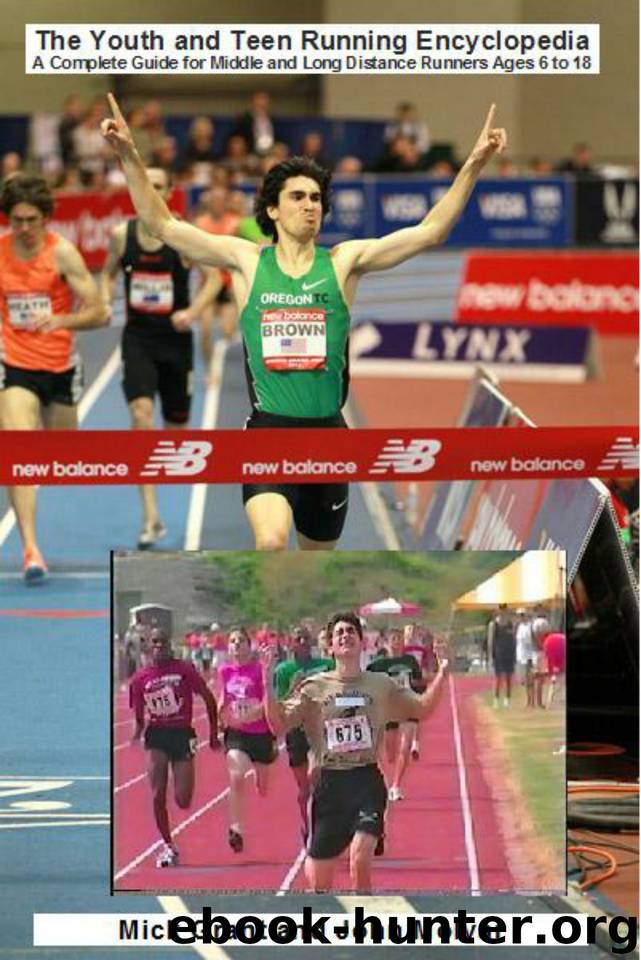The Youth and Teen Running Encyclopedia A Complete Guide for Middle And Long Distance Runners Ages 6 to 18 by Molvar John & Grant Mick

Author:Molvar, John & Grant, Mick [Molvar, John]
Language: eng
Format: epub
Publisher: Unknown
Published: 2014-01-04T05:00:00+00:00
**anaerobic over training and over racing limits the development of long term potential and can lead to burnout**
If kids are significantly under trained aerobically through high school, it is not ideal. I am suggesting gradual, consistent development of aerobic endurance.
**kids may give up the sport, since they don't understand the relationship between aerobic endurance training and performance* *
Aerobic endurance can be increased spectacularly over a long period of time. It is not something you can develop in a few weeks. If young athletes don’t develop a solid aerobic foundation in the first few years of training, in college they will be behind others, who have a more developed endurance foundation. Many aerobically under trained high school runners never get a chance to run in college, because they are deemed to be not good enough. Don’t delude yourself into thinking it is a good thing to be significantly aerobically under trained in high school. Developing a high level of aerobic conditioning is the most important factor in the long term development of a distance runner.
A scheduling system that allows high school middle distance and distance athletes to train more aerobically and avoid the over racing/over anaerobic training syndrome is important. A form of this is used in some places, but should be the norm. Many of the top middle and distance college programs reformed their similarly flawed system in the 1980s. They eliminated dual meets, reduced the number of competitions their athletes run in, and started their competitive seasons later. In the current, deeply flawed, high school system we have a situation where the good teams get better and the weak teams get worse. This happens because the good teams, with wise coaches, can afford to use early races as high aerobic tempo runs and/or hold out runners, and aerobically train through, and still win these meaningless meets, which keeps the less informed AD's and parents from complaining; so even though their official schedule may call for 15 races, they will only run about 5 all out races. (See Chapter 21 for a detailed description of how teams do this, and you can do this too at your high school.) This affords them a tremendous advantage and allows for more long term development. On the other hand, the weaker teams don't have this luxury and feel pressured to "chase points" and fight tooth and nail to win whatever number of the meaningless dual meets they can win to keep the parents and AD's from complaining, which results in 15 all out races per season, and a team full of fried runners, who make little progress from year to year, other than that which comes from natural physical maturation during the teen years.
Here is my long term proposal for improving the high school competition format:
1. Eliminate dual meet system and institute a quad meet system . Instead of 8-10 dual meets, have 3 quad meets. In track, have unseeded heats as necessary, so every kid on the team has a chance to compete.
Download
This site does not store any files on its server. We only index and link to content provided by other sites. Please contact the content providers to delete copyright contents if any and email us, we'll remove relevant links or contents immediately.
Periodization Training for Sports by Tudor Bompa(8175)
The Body: A Guide for Occupants by Bill Bryson(4978)
The MacArthur Bible Commentary by John MacArthur(4755)
The Sports Rules Book by Human Kinetics(4304)
What It Really Takes to Get Into Ivy League and Other Highly Selective Colleges by Hughes Chuck(3697)
Marijuana Grower's Handbook by Ed Rosenthal(3627)
The Sprouting Book by Ann Wigmore(3546)
The Martian by Andy Weir(3311)
Salt, Fat, Acid, Heat: Mastering the Elements of Good Cooking by Nosrat Samin(3108)
The Bread Bible by Rose Levy Beranbaum(3006)
Harry Potter 4 - Harry Potter and The Goblet of Fire by J.K.Rowling(2996)
Sapiens and Homo Deus by Yuval Noah Harari(2990)
The Marketing Plan Handbook: Develop Big-Picture Marketing Plans for Pennies on the Dollar by Robert W. Bly(2979)
Classic by Mary Berry(2947)
Martha Stewart's Baking Handbook by Martha Stewart(2801)
Screenplay: The Foundations of Screenwriting by Syd Field(2577)
The Plant Paradox by Dr. Steven R. Gundry M.D(2549)
50 Economics Classics by Tom Butler-Bowdon(2525)
The Cambridge Grammar Of The English Language by Rodney Huddleston Geoffrey K. Pullum(2388)
